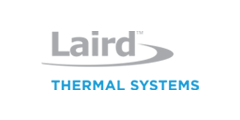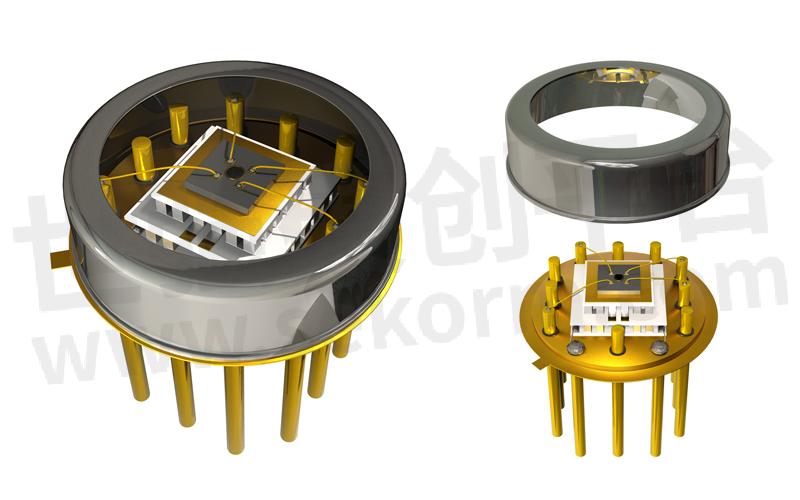Multistage Micro Thermoelectric Coolers for Miniature Optical Image Sensing Applications

Introduction
Miniature optical packages provide a robust hermetic seal to protect small image-sensing components, including CMOS, CCD, IR, and X-ray detectors. Optical packages, like Transistor Outline (TO) Cans, are widely used for image-sensing applications. For high-end image sensing, micro thermoelectric coolers (TECs) can be integrated into optical packages called Optical Thermoelectric Assemblies (TEAs). This will provide deep cooling to temperatures well below ambient to minimize thermal noise and capture maximum light spectrum. To achieve precise temperature control, cooling image sensors requires highly engineered micro Multistage TECs.
Miniature Optical Image Sensing Application Challenges
Miniature Optical TEAs are used in a wide variety of applications including thermal imaging, high-performance cameras, gas detectors, spectrometers, border security, digital microscopes, metrology, and defense applications to name a few. For these types of applications, Optical TEA designs present several challenges. These include thermal management, size constraints, optomechanical stability, manufacturing consistency, and cost optimization.

Optical Image Sensing Applications
Mechanical stresses and vibrations can significantly influence the alignment and stability of miniature Optical TEAs, which can impact the alignment and stability of optical components. Designers need to select optimal bonding methods and ensure robust process controls are in place during the manufacturing stage to assure strong bonding adhesion between components in assembly with overall tight tolerances.
Miniature optical packages, which are the key components of optical TEAs, are typically made from materials with low thermal conductivity, such as Kovar. This limits heat dissipation, which can affect the performance and reliability of the imaging sensor.
To ensure that the deep cooling temperature minimizes thermal noise, designers need to implement active cooling devices, such as micro TECs, as they adhere to size and cleanliness requirements. Form factors continue to shrink into smaller packages, requiring higher precision assembly methods to pack smaller thermoelectric elements into tighter densities. TECs can withstand rigorous cleanliness methods and harsh solvents to assure no degradation occurs that can impact reliability.
Multistage TECs can achieve higher temperature differentials between the hot and cold sides compared to single-stage TECs, providing greater cooling or heating capabilities. Careful design consideration of the multistage TEC is needed to balance cooling capacity requirements against temperature differential to maintain the highest coefficient of performance, (COP).
The main type of thermoelectric coolers used in optical packages are multistage micro TECs.
Multistage TECs
A multistage micro thermoelectric cooler, or cascade thermoelectric module, consists of multiple single-stage thermoelectric TECs connected in series electrically and thermally. Each stage of the TEC has its own set of thermoelectric couples, and the stages are arranged in a cascaded configuration. Offering application-specific configurability, a multistage TEC delivers a higher temperature differential compared to a single-stage thermoelectric cooler. By cascading stages, the temperature difference can increase with each stage, allowing it to reach colder temperatures. Multistage thermoelectric devices can provide cooling capacities ranging from milli-watts to watts, depending on the specific configuration and design.
In general, simple image-sensing applications would normally not require a TEC. However, as the importance of image resolution increases for high-performance applications, the more critical multistage micro TECs become.
The selection of multistage micro TECs for optical packages is based on several key factors.
1. Optimized TEC Design: application requirements need to be thoroughly understood at the desired operating point. The geometry factor, number of couples and number of stages should be optimized to match heat removal requirements from the image sensor plus passive heat losses. Thermal resistances of the hot and cold sides need to be accounted for as they will reduce temperature differential across the thermoelectric cooler. Power consumption is an important consideration, especially in applications that require portable battery operation. The following is an approximation of micro TEC cooling temperatures that can be achieved by stage:
• 1 stage micro TEC down to -20℃ below ambient
• 2-stage micro TEC down to -40℃ below ambient
• 3-stage micro TEC down to -60℃ below ambient
• 4-stage micro TEC down to -80℃ below ambient
2. Package Design: the least expensive package in the smallest form factor is often chosen. However, the package is the key heat dissipation mechanism, and may not have the best thermal conductivity. As the form factor of the package shrinks, the heat flux density increases and poor heat dissipation can lead to thermal runaway. This can be avoided by sizing the package and thermal conductivity of the material to accommodate the total heat that needs to be rejected from the TEC, image sensor and parasitic heat losses.
3. Interface between TEC and Package: The solderability of the TEC to the optical package is critical to assure proper heat rejection from the TEC. Poor solder adhesion leads to solder voiding and this increases the hot side thermal resistance. Proper plating materials need to be specified on ceramic substrate surfaces of the TEC in combination with optimal solder construction to assure a thin bond layer is achieved with minimal solder voiding. This will have maximum impact by increasing the operating efficiency of the TEC.
4. Parasitic Losses: Passive heat losses can occur from a thermal short between the hot and cold side of the TEC. Most packages are hermetically sealed in a vacuum or gas, so this minimizes thermal losses from passive heat in the surrounding environment. However, lead attachments to the TEC, imaging sensor, and NTC thermistor on the cold side substrate of the TEC are susceptible to heat transfer from the lead wires. This will cause the TEC to consume more input power to achieve the same cooling power required. It is ideal to design the TEC to operate at a lower current since this will reduce the gauge thickness of the lead wire and reduce heat transfer from the lead wires.
5. Form Factor: The size and form factor of multistage micro TECs are important, particularly in space-constrained TO-39 packages. Micro TECs with smaller footprints down to 2.0mm x 4.0mm allow for easier integration into optical packages without compromising the performance of other devices. Height is particularly critical as the imaging sensor is mounted on top resulting in tight tolerances.
6. Outgassing: Managing outgassing is crucial in thermal management solutions for imaging systems to prevent contamination on the optical lens and reduction of image resolution. The impact of outgassing on the imaging system can be minimized by selecting materials that do not outgas, applying appropriate treatments or coatings, considering design aspects, and conducting thorough testing. This will ensure optimal performance and reliability.
Once the main design variables have been determined, the TEC is controlled by a temperature control circuit, which adjusts the current supplied to the TEC to maintain the imaging sensor at the desired control temperature. Other variables to consider are substrate materials and solder construction of the TEC. Materials exist with higher thermal conductivity and solder adhesion, which boost performance, heat spreading and reliability, but they must be weighed against cost targets of the end application.
MSX Series
The MSX Series utilizes advanced ceramic materials, proprietary solder bonding technics and next-generation thermoelectric materials to boost cooling capacity by as much as 10% – all in a micro footprint.
Multistage MSX Series micro TECs offer footprints on the cold side down to 2.0 x 4.0 mm with thicknesses down to:
• 3.3 mm for 2 stages
• 3.8 mm for 3 stages
• 4.9 mm for 4 stages
The packing fraction for thermoelectric elements enables a high heat pumping capacity of up to 5 Watts, with lower operating currents than traditional multistage coolers. Featuring solid-state construction for long-life reliability and no maintenance, the Micro multistage thermoelectric coolers deliver reliable temperature stabilization from room temperature down to 180 Kelvin with no outgassing.
Advanced Process Automation
Manufactured in the USA, Laird Thermal Systems has invested in advanced automation equipment in-house, to integrate multistage micro thermoelectric coolers into miniature Optical TEAs. This saves customers the burden of integrating TECs into their optical packages, thereby reducing assembly time and cost, and improving repeatability. Additional benefits to OEMs and their design engineers include:
Simplified Integration - design engineers can easily integrate the cooling solution into their existing imaging system without the need for significant modifications or customizations. This simplifies the design process and reduces time-to-market.
Quality Assurance - Combining proprietary optical thermoelectric assembly capabilities with minimal solder voiding ensures customers receive high-quality cooling devices with consistent and repeatable performance.
Reliable Supply Chain - results in reduced lead times, easier procurement, and facilitates fulfilling production demand schedules.
OEMs no longer need to be concerned with investing in tooling and process equipment, lowering development costs, or keeping production schedules on track.

Optical TEA package
TO Can with Cap off and on, including Image Sensor and MSX Series Thermoelectric Cooler
Conclusion
Micro multistage thermoelectric coolers offer multiple advantages for advanced image sensing applications. Micro thermoelectric coolers provide precise, localized thermal control in microscale environments, rapid cooling to very low temperatures, high thermal efficiency, solid-state operation, low power consumption, and can be customized to easily scale up or down depending on the specific application requirements. Supplying micro thermoelectric coolers in Optical TEAs provides additional benefits including ease of integration, space-efficient design, optimized thermal performance, quality assurance, cost-effectiveness, and improved product performance.
- +1 Like
- Add to Favorites
Recommend
- Laird Thermal Systems MSX Series: Advanced Thermoelectric Cooling Solutions for High Performance Imaging Sensing Applications
- Laird Thermal Systems’ Prototyping Liquid Cooling Systems
- Laird Thermal Systems Unveils Micro Multistage Thermoelectric Cooler & Optical TEAs Integration Capability
- Laird Thermal Systems Commits to Sustainable Principles with SBTi-Endorsed Emissions Goals
- Laird Thermal Systems to Showcase Next Generation Active Cooling Technologies at CIOE 2024 - China International Optoelectronic Exhibition
- Laird Thermal Systems Custom Solutions for Cooling Medical X-ray Imaging Equipment
- Laird Thermal Systems‘ Testing Liquid Cooling Systems Can Be Tailored According to Customer Specifications and Applicable Industry Standards
- PowerCycling PCX Elongated Thermoelectric Coolers from Laird Thermal Systems Speed up PCR Testing
This document is provided by Sekorm Platform for VIP exclusive service. The copyright is owned by Sekorm. Without authorization, any medias, websites or individual are not allowed to reprint. When authorizing the reprint, the link of www.sekorm.com must be indicated.





























































































































































































































































































































































































































































































































































































































































































































































































































































































